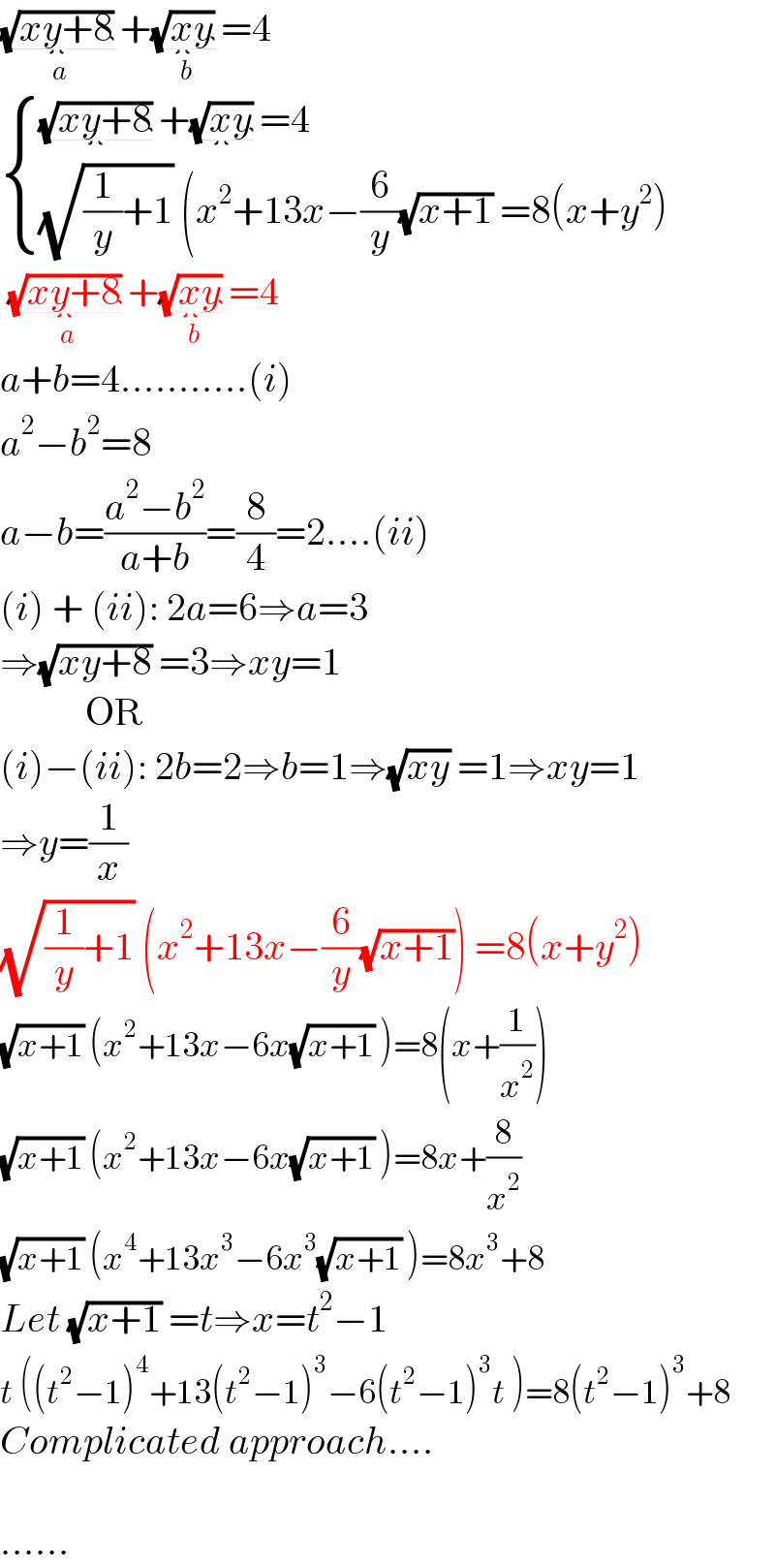
Question Number 200025 by cortano12 last updated on 12/Nov/23

Answered by Frix last updated on 12/Nov/23

$$\left(\mathrm{1}\right)\:\:\:\:\:\sqrt{{t}+\mathrm{8}}+\sqrt{{t}}=\mathrm{4}\:\Rightarrow\:{t}=\mathrm{1}\:\Rightarrow\:{y}=\frac{\mathrm{1}}{{x}} \\ $$$$\mathrm{Transforming}\:\left(\mathrm{2}\right)\:\mathrm{to} \\ $$$${x}^{\mathrm{3}} \left({x}+\mathrm{13}\right)\sqrt{{x}+\mathrm{1}}=\mathrm{6}{x}^{\mathrm{4}} +\mathrm{14}{x}^{\mathrm{3}} +\mathrm{8} \\ $$$${x}^{\mathrm{3}} \left({x}+\mathrm{13}\right)\sqrt{{x}+\mathrm{1}}=\mathrm{2}\left({x}+\mathrm{1}\right)\left(\mathrm{3}{x}^{\mathrm{3}} +\mathrm{4}{x}^{\mathrm{2}} −\mathrm{4}{x}+\mathrm{4}\right) \\ $$$${x}=−\mathrm{1}\wedge{y}=−\mathrm{1}\:\bigstar \\ $$$${x}^{\mathrm{3}} \left({x}+\mathrm{13}\right)=\mathrm{2}\left(\mathrm{3}{x}^{\mathrm{3}} +\mathrm{4}{x}^{\mathrm{2}} −\mathrm{4}{x}+\mathrm{4}\right)\sqrt{{x}+\mathrm{1}} \\ $$$${t}=\sqrt{{x}+\mathrm{1}}\geqslant\mathrm{0} \\ $$$${t}^{\mathrm{8}} −\mathrm{6}{t}^{\mathrm{7}} +\mathrm{9}{t}^{\mathrm{6}} +\mathrm{10}{t}^{\mathrm{5}} −\mathrm{33}{t}^{\mathrm{4}} +\mathrm{6}{t}^{\mathrm{3}} +\mathrm{35}{t}^{\mathrm{2}} −\mathrm{18}{t}−\mathrm{12}=\mathrm{0} \\ $$$$\left({t}^{\mathrm{2}} −\mathrm{2}{t}−\mathrm{1}\right)\left({t}^{\mathrm{6}} −\mathrm{4}{t}^{\mathrm{5}} +\mathrm{2}{t}^{\mathrm{4}} +\mathrm{10}{t}^{\mathrm{3}} −\mathrm{11}{t}^{\mathrm{2}} −\mathrm{6}{t}+\mathrm{12}\right)=\mathrm{0} \\ $$$$\mathrm{The}\:\mathrm{2}^{\mathrm{nd}} \:\mathrm{factor}\:\geqslant\mathrm{3} \\ $$$$\Rightarrow\:{t}=\mathrm{1}+\sqrt{\mathrm{2}}\:\Rightarrow \\ $$$${x}=\mathrm{2}+\mathrm{2}\sqrt{\mathrm{2}}\wedge{y}=−\frac{\mathrm{1}}{\mathrm{2}}+\frac{\sqrt{\mathrm{2}}}{\mathrm{2}}\:\bigstar \\ $$
Answered by Rasheed.Sindhi last updated on 12/Nov/23

$$\underset{{a}} {\underbrace{\sqrt{{xy}+\mathrm{8}}\:}}+\underset{{b}} {\underbrace{\sqrt{{xy}}\:}}=\mathrm{4} \\ $$$$\begin{cases}{\underbrace{\sqrt{{xy}+\mathrm{8}}\:}+\underbrace{\sqrt{{xy}}\:}=\mathrm{4}}\\{\sqrt{\frac{\mathrm{1}}{{y}}+\mathrm{1}}\:\left({x}^{\mathrm{2}} +\mathrm{13}{x}−\frac{\mathrm{6}}{{y}}\sqrt{{x}+\mathrm{1}}\:=\mathrm{8}\left({x}+{y}^{\mathrm{2}} \right)\right.}\end{cases} \\ $$$$\:\underset{{a}} {\underbrace{\sqrt{{xy}+\mathrm{8}}\:}}+\underset{{b}} {\underbrace{\sqrt{{xy}}\:}}=\mathrm{4} \\ $$$${a}+{b}=\mathrm{4}...........\left({i}\right) \\ $$$${a}^{\mathrm{2}} −{b}^{\mathrm{2}} =\mathrm{8} \\ $$$${a}−{b}=\frac{{a}^{\mathrm{2}} −{b}^{\mathrm{2}} }{{a}+{b}}=\frac{\mathrm{8}}{\mathrm{4}}=\mathrm{2}....\left({ii}\right) \\ $$$$\left({i}\right)\:+\:\left({ii}\right):\:\mathrm{2}{a}=\mathrm{6}\Rightarrow{a}=\mathrm{3} \\ $$$$\Rightarrow\sqrt{{xy}+\mathrm{8}}\:=\mathrm{3}\Rightarrow{xy}=\mathrm{1} \\ $$$$\:\:\:\:\:\:\:\:\:\:\:\mathrm{OR} \\ $$$$\left({i}\right)−\left({ii}\right):\:\mathrm{2}{b}=\mathrm{2}\Rightarrow{b}=\mathrm{1}\Rightarrow\sqrt{{xy}}\:=\mathrm{1}\Rightarrow{xy}=\mathrm{1} \\ $$$$\Rightarrow{y}=\frac{\mathrm{1}}{{x}} \\ $$$$\sqrt{\frac{\mathrm{1}}{{y}}+\mathrm{1}}\:\left({x}^{\mathrm{2}} +\mathrm{13}{x}−\frac{\mathrm{6}}{{y}}\sqrt{{x}+\mathrm{1}}\right)\:=\mathrm{8}\left({x}+{y}^{\mathrm{2}} \right) \\ $$$$\sqrt{{x}+\mathrm{1}}\:\left({x}^{\mathrm{2}} +\mathrm{13}{x}−\mathrm{6}{x}\sqrt{{x}+\mathrm{1}}\:\right)=\mathrm{8}\left({x}+\frac{\mathrm{1}}{{x}^{\mathrm{2}} }\right) \\ $$$$\sqrt{{x}+\mathrm{1}}\:\left({x}^{\mathrm{2}} +\mathrm{13}{x}−\mathrm{6}{x}\sqrt{{x}+\mathrm{1}}\:\right)=\mathrm{8}{x}+\frac{\mathrm{8}}{{x}^{\mathrm{2}} } \\ $$$$\sqrt{{x}+\mathrm{1}}\:\left({x}^{\mathrm{4}} +\mathrm{13}{x}^{\mathrm{3}} −\mathrm{6}{x}^{\mathrm{3}} \sqrt{{x}+\mathrm{1}}\:\right)=\mathrm{8}{x}^{\mathrm{3}} +\mathrm{8} \\ $$$${Let}\:\sqrt{{x}+\mathrm{1}}\:={t}\Rightarrow{x}={t}^{\mathrm{2}} −\mathrm{1} \\ $$$${t}\:\left(\left({t}^{\mathrm{2}} −\mathrm{1}\right)^{\mathrm{4}} +\mathrm{13}\left({t}^{\mathrm{2}} −\mathrm{1}\right)^{\mathrm{3}} −\mathrm{6}\left({t}^{\mathrm{2}} −\mathrm{1}\right)^{\mathrm{3}} {t}\:\right)=\mathrm{8}\left({t}^{\mathrm{2}} −\mathrm{1}\right)^{\mathrm{3}} +\mathrm{8} \\ $$$${Complicated}\:{approach}.... \\ $$$$ \\ $$$$...... \\ $$
Answered by MathematicalUser2357 last updated on 15/Nov/23

$$\mathrm{Yay},\:\mathrm{200K}! \\ $$
